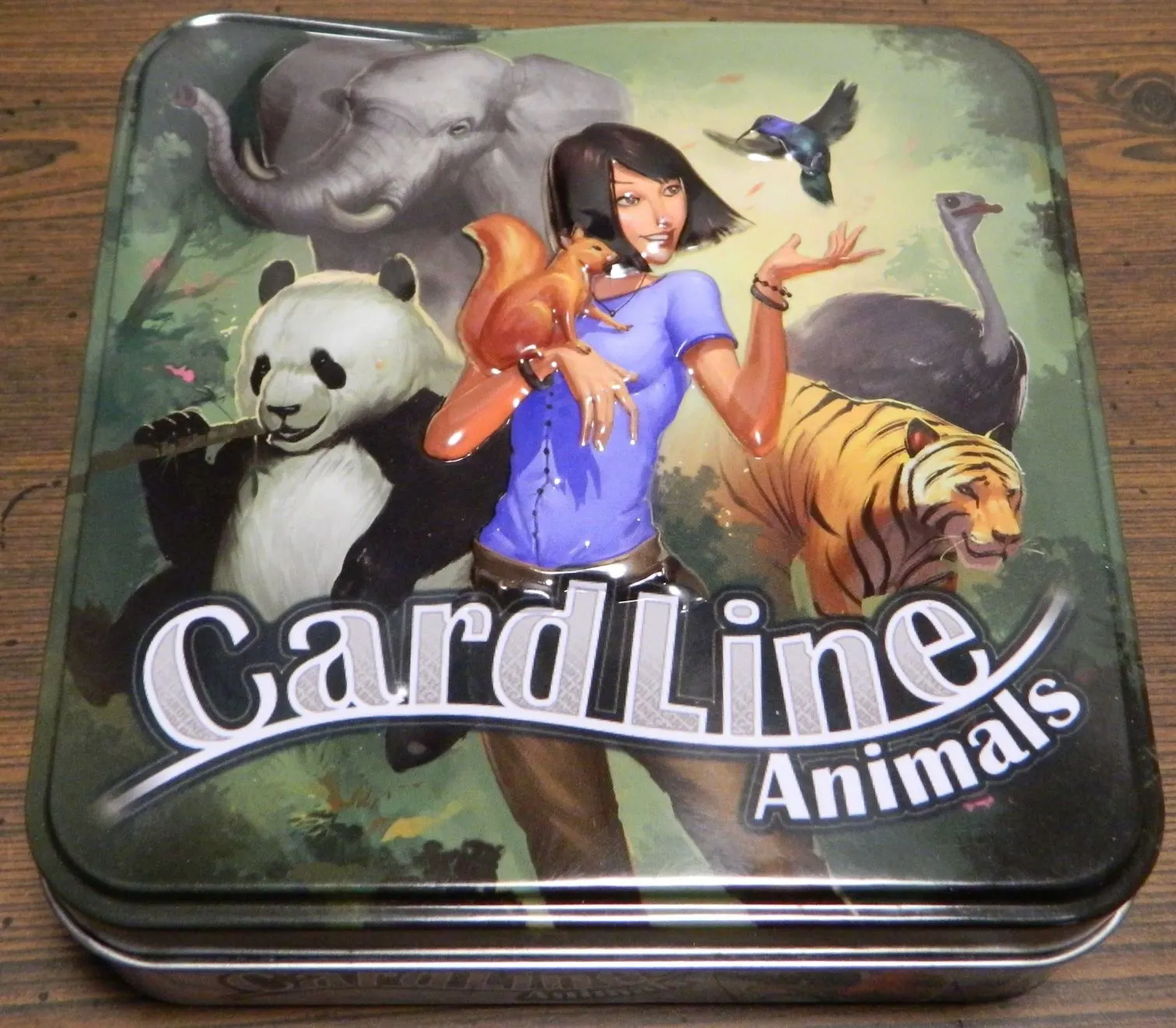Probably at least seven years ago I first encountered the card game Chronology. I knew nothing about the game and didn’t have super high expectations for it. The main reason I even picked it up was because the game was so cheap. As soon as I played Chronology though I was genuinely impressed as it was a really clever take on your typical historical trivia game. Instead of having to answer bland questions about when different events happened, you try to place events in chronological order to create a long chronological chain of historical events. I bring this up because a similar mechanic was used in the Timeline series. I don’t know if the designer of the Timeline series, Frédéric Henry, was familiar with Chronology, but it basically utilized the same mechanic. With the success of the Timeline series the franchise branched off into the Cardline series which took the same gameplay mechanic and applied it to topics other than historical events. This brings me to today where I am taking a look at Cardline: Animals where the timeline mechanic is applied to animals’ sizes, weights and lifespans. Cardline: Animals may not be for everyone, but it is a genuinely clever trivia game and probably one of the best animal trivia games ever created.
How to Play Cardline: Animals
Setup
- The players will decide which of the three characteristics they will use to rank the animals on the cards. They can choose to rank the animals based on their size, weight, or lifespan.
- Shuffle the cards. Deal four cards to each player with the characteristics side being placed face down.
- The rest of the cards will form the draw pile with the cards being placed characteristics side face down. Take the first card from the draw pile and place it in the middle of the table characteristic side face up. This card will be the initial card for the game.
- Choose which player will start the game.
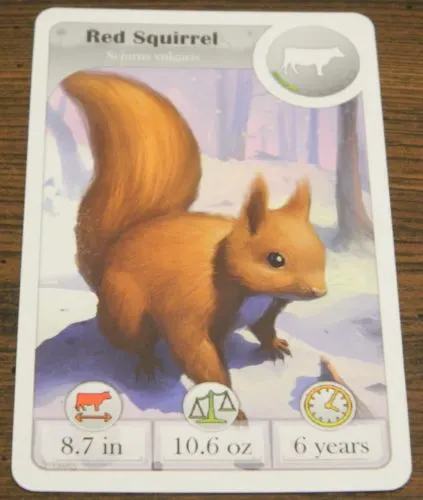
This is the first card for this game. The rest of the cards in the game will be placed in relation to the red squirrel. In this game the players have chosen to rank the animals by their weight.
Playing the Game
The first player will begin the game by choosing one of their four cards that they think they can correctly place next to the initial card. Based on the characteristic chosen (size, weight, lifespan) the player will choose if they think their chosen card is smaller/shorter or larger/longer. If the player thinks their animal is smaller/shorter they will place it to the left of the other card. If they think their animal is larger/longer they will place it to the right of the initial card.
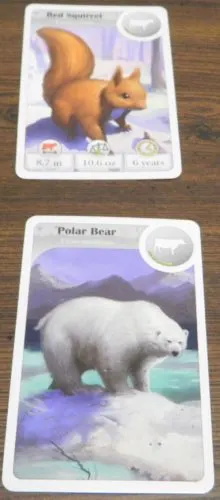
This player has chosen to play their polar bear card. If they think the polar bear weighs less than the red squirrel (it obviously doesn’t) they will place the card to the left of the red squirrel. If they think it weighs more they will place it to the right.
Once the player plays the card they will flip it over to the characteristics side and compare it to the other card. If the player played the card properly it will stay where it was played with the characteristics side face up. If the card was played incorrectly it will be returned to the box. The player will then add the top card from the draw pile to their group of cards.
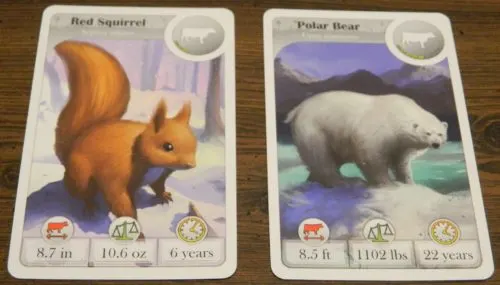
This player correctly placed the polar bear so the card stays in place and they don’t have to draw another card.
In the case that two cards match exactly in the chosen characteristic it does not matter which card was placed earlier in the chain.
The next player will then take their turn. They will try to place their card correctly based on the card(s) in the middle of the table. When there is more than one card on the table the player can choose to place it before all of the cards, after all of the cards, or between two of the cards. When they turn the card over they must see if the card was placed in the right position inside the chain. If the card was placed correctly among all of the cards it will stay where it was placed.
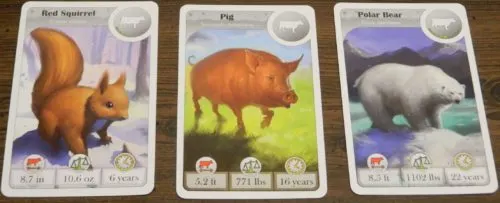
This player thought the pig weighed more than the red squirrel but less than the polar bear. They were correct so it stays where it was placed.
If it was placed incorrectly it will be discarded and the player will draw a new card.
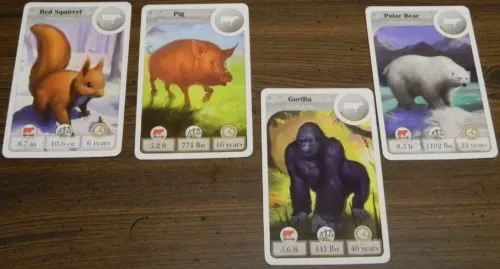
This player though the gorilla weighed more than a pig but less than a polar bear. They were wrong as the gorilla should have been placed between the red squirrel and the pig. The gorilla will be discarded and the player who played it will have to draw a new card.
Players will keep taking turns trying to add one of their cards to the chain of cards in the middle of the table.
End of Game
When a player successfully gets rid of their last card the game will end at the end of the current round (each player has had the same number of turns). If only one player got rid of all of their cards that player has won the game. If two of more players get rid of their last card in the same round all of the tied players will continue playing while the other players are out of the game. Each tied player will draw one card and the players will take turns adding them to the chain. When only one of the tied players place their card correctly they will win the game.
My Thoughts on Cardline: Animals
As I mentioned at the beginning of the review ever since I first played Chronology I have loved the premise of building a trivia game around a timeline. While I am a fan of trivia games, too many games in the genre are quite bland. In particular trivia games about historical events can be pretty boring. How exciting is it to name the specific year that an event took place. Instead of just asking generic trivia questions that you would find on a history test why not make it a little more fun. This is what I loved about Chronology’s timeline mechanic which was also used in the Timeline series. Instead of having to know exact dates you only need to have a generic idea of when an event happened. You then need to figure out where an event happened in relation to other events. This is such a simple mechanic that makes a trivia game about history much more exciting.
This brings me to Cardline: Animals. I was curious how this mechanic was going to work with something other than historical events. It makes sense with events as you just place them in chronological order. When you think about it though it makes sense that the mechanic could apply to a bunch of different topics. In Cardline: Animals you obviously don’t rank the animals based on time. Instead the game gives you three different ways to rank the animals. Two pretty obvious ways is by size and weight. The category that is a little more surprising is lifespan.
I was curious about how well the mechanic would translate to categories other than a timeline. The good news is that the mechanic translates perfectly to other categories. Cardline: Animals basically plays exactly the same as a game like Chronology or Timeline except that you are ranking animals by three different characteristics. This works so seamlessly that it maintains all of the fun of the mechanic. There is just something really satisfying about this mechanic. If you have any interest in trying to rank animals by their size, weight, or lifespan you should have a lot of fun with the game. While I have played few animal trivia games I am confident that Cardline: Animals is one of the best ever created.
I think one of the reasons that this mechanic works so well is that it is so simple. You could probably teach the game to new players within a minute or two. The mechanics are just so simple. Choose one of your cards and choose where it would rank based on the chosen characteristic compared to the other cards already played. That is all there is to the game. The game is so simple that people who generally shy away from board games should have no problems with the game. I am honestly a little surprised that the recommended age for the game is 7+. Younger players may not be great at the game, but I see no reason why they shouldn’t be able to play it. I think younger children will really enjoy the game as well since it features a lot of animals. Any kid who loves animals should love the game.
So with the game being so easy to play the question becomes how easy is the trivia aspect of the game. I would say that kind of depends. Players that know more about animals will have a distinct advantage in the game as they will know more about the specific animals. There is an element of luck to the game though which means that everyone even those who know little about animals will have a chance in the game. The ultimate difficulty in the game comes down to a couple factors.
First Cardline: Animals is a game that starts off pretty easy and becomes quite a bit more difficult as the game progresses. To begin the game you will only have to compare one of your cards among just a couple different animals. This means that there should be pretty large gaps in the cardline. Therefore you should have a card that easily fits into the line. You should either have an animal that is quite a bit smaller or larger than the other cards that have been played so far. Your first and possibly second play should be pretty obvious. Based on the premise alone though the game naturally gets more complicated. As more and more cards get added to the line it becomes more difficult to place cards. The gaps becomes smaller which makes it much harder to find exactly where you should place cards. You may even encounter cards that have the exact same number for the chosen characteristic. This is an interesting ramp up in difficulty as the beginning of a game can be quite easy while your last card or two will be quite hard to play.
This leads me to the second factor that impacts the game’s difficulty. The cards that you have to play will play a pretty big role in how well you do in the game. Based on the cards already in the line not all of the cards are considered equal. Take the size category for example. Placing an animal of a medium size is normally going to be much harder to place than a tiny or huge animal. The gaps in the cardline are also important. Cards that are of a different size than the animals already placed will be much easier to place than cards that are about the same size as the animals already played. This fact adds most of the luck to the game. In some ways I don’t mind the luck as it gives all of the players a chance even if they don’t know a lot about animals. At times it adds too much luck though where you kind of need some luck on your side if you want to win.
The final thing that impacts the difficulty is the category that you choose to use. It might just be me but size and weight are by far the two easiest categories in the game. Just by looking at a picture of an animal you can get a general idea of how big it is and how much it weighs. There will be the occasional animal that is surprisingly smaller or larger than you expected, but you will usually have a pretty good idea of their size. Lifespan on the other hand is a lot harder to pin down unless you know a lot about animals. Some animals will be really obvious as you know they either live a really long or short life. There are many more animals though that you genuinely have to just guess. I was genuinely surprised by quite a few of the lifespans of the animals we played with. If you want an easier game I would recommend sticking with size or weight. If you want a real challenge though I would recommend upgrading to the lifespan category.
Speaking of the three categories this is one of the things that I really liked about Cardline: Animals. In Chronology and the Timeline series you can only rank the cards by one category, date. With three different categories though there is considerably more variety in Cardline: Animals. You have more options in choosing how to play the game as you can easily switch categories between each game. It also adds considerably more replay value to the game. The game already has quite a bit of replay value as the odds of you having to compare the same cards is pretty slim. By adding three different categories though you add even more replay value.
As for the length of individual games I would say that the game plays really quickly. The length is going to depend on how well the players do, but I see most games only taking around 10-15 minutes. For the most part I like this shorter length as it works great as a filler game. It also allows you to quickly play a rematch game. I do think the game maybe should have been a little longer though. This isn’t really an issue though as it is easy to make the game longer. All you need to do to make the game longer is to give players more cards to start the game. This will make the game longer as you have to place more cards. It will also make the game considerably more difficult as the gaps at the end of the game will be much smaller making it harder to place a card. Once you become familiar with the game I would probably recommend adding a couple more cards to each player’s starting hand to up the difficulty.
Cardline: Animals’ components are also really good. The standout is the game’s artwork which is fantastic. Any animal lovers should really enjoy the artwork. The cards are also designed really well where they aren’t cluttered with useless information. The game does a good job laying out the information where it is easy to find and compare across cards. The cards do a good job supporting the educational element of the game. Cardline: Animals is not going to be the most educational game that you can play, but you are likely to learn some new information while playing the game. The game even includes quite a few cards. The game has 110 cards. I obviously would have liked more (who wouldn’t?), but the game has enough cards that you shouldn’t have to worry about the game getting repetitive for quite some time. The game even comes in a nice tin box which is the perfect size for the game. I honestly couldn’t really find any complaints with the components.
Should You Buy Cardline: Animals?
Before playing Cardline: Animals I was a little skeptical about how the timeline mechanic was going to translate to a game about animals. The good news is that the transition was pretty seamless. Basically Cardline: Animals is about ranking animals based on their size, weight, or lifespan. You take one of the cards and try to correctly place it among the other animal cards based on the chosen category. The goal is to try and get rid of all of your cards before the other players. One of the game’s greatest strengths is that you can teach it in about a minute or two and pretty much anyone should be able to play it. The game can still be challenging though as the first cards you play can be easy, but each card that get played makes the game more difficult. The game relies on a little too much luck at times, but it provides enough challenge to create a truly innovative take on your traditional trivia game. Cardline: Animals’ components are also really good.
If you aren’t really into trivia game or animals in general I don’t see Cardline: Animals being for you. People who have any interest in the game though should really consider picking it up as it is arguably one of the best animal trivia games ever created.

